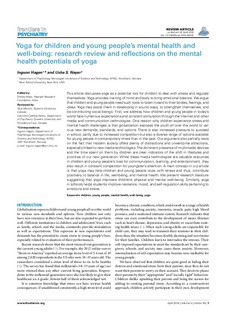| dc.description.abstract | This article discusses yoga as a potential tool for children to deal with stress and regulate themselves. Yoga provides training of mind and body to bring emotional balance. We argue that children and young people need such tools to listen inward to their bodies, feelings, and ideas. Yoga may assist them in developing in sound ways, to strengthen themselves, and be contributing social beings. First, we address how children and young people in today’s world face numerous expectations and constant stimulation through the Internet and other media and communication technologies. One reason why children experience stress and mental health challenges is that globalization exposes the youth all over the world to various new demands, standards, and options. There is also increased pressure to succeed in school, partly due to increased competition but also a diverse range of options available for young people in contemporary times than in the past. Our argument also partially rests on the fact that modern society offers plenty of distractions and unwelcome attractions, especially linked to new media technologies. The dominant presence of multimedia devices and the time spent on them by children are clear indicators of the shift in lifestyles and priorities of our new generation. While these media technologies are valuable resources in children and young people’s lives for communication, learning, and entertainment, they also result in constant competition for youngster’s attention. A main concept in our article is that yoga may help children and young people cope with stress and thus, contribute positively to balance in life, well-being, and mental health. We present research literature suggesting that yoga improves children’s physical and mental well-being. Similarly, yoga in schools helps students improve resilience, mood, and self-regulation skills pertaining to emotions and stress. | nb_NO |

